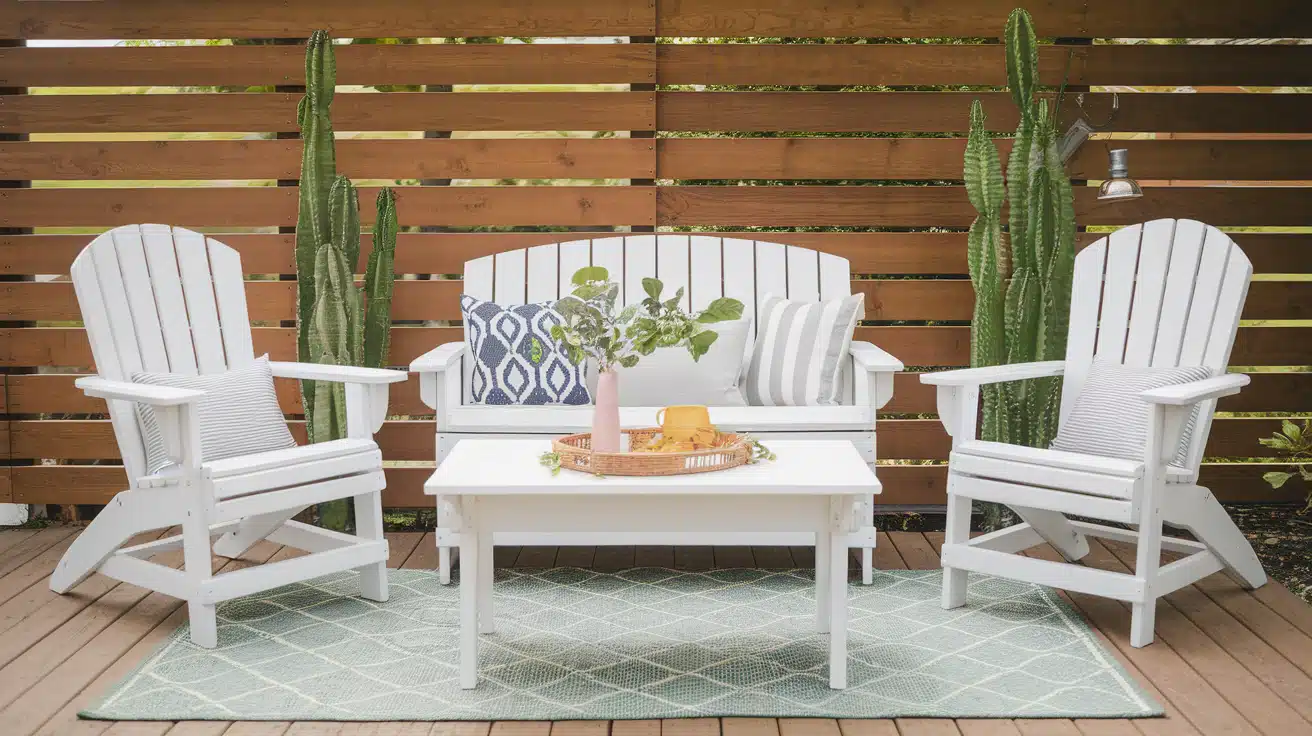Want to refresh your outdoor furniture without buying new pieces? Chalk painting offers a simple way to breathe new life into old tables, chairs, and other outdoor items.
With just a few basic tools and materials, you can change the look of your porch or patio in a single afternoon. This method works well for beginners and experienced painters alike.
The paint sticks to most surfaces without much prep work. I’ll walk you through each step, from cleaning to sealing. By the end, you’ll know how to turn that faded table into something you’ll be proud to show off when guests visit.
Let’s start making your outdoor space look fresh again.
Why Chalk Paint is Perfect for Outdoor Furniture?
Chalk paint is an ideal choice for outdoor projects because it can stick to almost any surface with minimal preparation. Unlike regular paint, you don’t need to strip or prime the furniture first. The matte finish gives items an aged, vintage look that many find appealing.
The paint dries quickly, allowing you to finish projects in one day. When sealed properly, chalk-painted furniture can withstand weather changes for years.
Plus, if you want to change the colors later, you can paint over it again.
Must-Have Materials for a Smooth Chalk Paint Finish
| Item | Purpose |
|---|---|
| Chalk paint (chosen color) | Main paint for furniture surface |
| Clear lacquer or wax | Seals and protects the painted surface |
| Sandpaper (60 & 120 grit) | 60-grit for distressing; 120 grit for prepping surface |
| Clean rags or cloths | For cleaning and applying wax or lacquer |
| Paint brushes (various sizes) | For painting different areas, corners, and details |
| Drop cloth | Protects floors and surfaces from paint spills |
| Cleaning supplies (soap, water) | Prep and clean the furniture before painting |
| Gloves | Protects hands from paint and chemicals |
| Mask | Prevents inhalation of dust during sanding |
| Painter’s tape | Masks off areas you don’t want to paint |
Outdoor Furniture Makeover: Step-by-Step Guide
Step 1: Clean the Furniture
Start by removing all dust, dirt, and grime from your furniture. Use a damp cloth to wipe down all surfaces. For outdoor furniture that has been sitting through winter, you may need to scrub it with mild soap and water.
Reach all small spaces and corners. Let the furniture dry fully before proceeding to the next step, as moisture can affect paint adhesion.
Step 2: Light Sanding
While chalk paint doesn’t usually require sanding, a light sanding helps with adhesion for outdoor items. Use 120-grit sandpaper to rough up the surface gently. Focus on smooth or glossy areas where paint might have trouble sticking.
After sanding, wipe away all dust with a damp cloth. This step creates a better bond between the paint and the furniture, helping your finish last longer.
Step 3: Apply First Coat of Paint
Open your chalk paint and stir well. Apply the first coat with a good-quality brush, working in long, even strokes. Don’t worry if the coverage seems thin—chalk paint often needs two coats. Paint in the direction of the wood grain when possible.
Work from top to bottom to catch any drips. Let this first coat dry completely, which usually takes 1-2 hours, depending on the weather.
Step 4: Apply Second Coat and Distress
After the first coat dries, apply a second coat for full coverage. Once this coat dries (wait at least 2 hours), you can create a distressed look if desired. Use 60-grit sandpaper to gently sand edges, corners, and natural wood features.
Focus on areas that would naturally wear over time. Don’t overdo it – you can always sand more, but you can’t undo too much distressing.
Check out our blog on how to distress wood. And learn the various techniques to do it!
Step 5: Seal the Finish
Sealing your chalk-painted furniture is crucial for outdoor use. Apply a clear lacquer or outdoor-rated wax with a clean brush or cloth. Make sure to cover all painted surfaces with a thin, even coat.
The sealer protects against rain, sun, and daily wear. According to the product instructions, allow the sealer to dry completely before placing items on the furniture or exposing it to the elements.
Video Tutorial
Check out this YouTube video for a detailed step-by-step Tutorial on chalk painting Outdoor Furniture
Effective Strategies for Maintaining Painted Outdoor Furniture
1. Regular Cleaning
Clean your painted outdoor furniture every few weeks with a soft cloth and mild soap solution. Avoid harsh cleaners that might damage the finish. A dry microfiber cloth works well for light dust and pollen.
Regular cleaning prevents dirt buildup that can wear down the protective finish over time.
2. Touch-up Techniques
When you notice small chips or scratches, touch them up right away to prevent further damage. Keep extra paint for these fixes. Clean the area, apply a small amount of paint with a fine brush, and seal when dry.
Quick repairs extend the life of your furniture and keep it looking fresh throughout the seasons.
3. Seasonal Protection
At the end of each season, check for any areas that need attention. In harsh winter climates, consider storing painted furniture indoors or using furniture covers. If you can’t move the items, apply an extra coat of sealer before winter.
This extra protection helps the furniture withstand snow, ice, and cold temperatures.
4. Preventing Fading
If possible, place your furniture away from constant direct sunlight. While sealed chalk paint resists fading better than some finishes, all outdoor items will fade over time. Rotate cushions and accessories to ensure even sun exposure.
If the furniture sits in full sun daily, you might need to repaint it every few years.
5. Handling Water Damage
If water pools on your furniture after rain, pat it dry with a clean towel. Over time, standing water can seep into the wood, even through the sealer. Check the underside of tables and chairs for water damage, as these areas often get overlooked.
Reapply sealer to any spots that show signs of water seeping through the finish.
Outdoor Chalk Painting Pitfalls to Watch For
| Don’t Do This | Why It’s a Problem |
|---|---|
| Skip the sealing step | Paint will chip and peel quickly when exposed to weather |
| Use indoor chalk paint for outdoor projects | Not all chalk paints are meant for outdoor use; check the label |
| Paint in direct sunlight | The paint dries too quickly and doesn’t level properly |
| Paint in high humidity | Extends drying time and may create a tacky finish |
| Apply thick coats | Can lead to cracking and peeling; multiple thin coats work better |
| Rush the drying time | Each layer needs to dry fully for best results |
| Use steel wool for distressing | Can leave metal particles that rust over time |
If Not Chalk Paint: What Else Works for Outdoor Furniture?
While chalk paint offers many benefits for outdoor furniture, these other options might work better for certain projects:
- Dedicated exterior paints (latex, acrylic): These paints contain special additives that help them withstand harsh weather without extra sealing steps.
- Exterior stains (for wood): Wood stains soak into the material instead of sitting on top, showing off the natural grain while adding color and protection.
- Spray paints formulated for outdoor use: Spray options give smooth, even coverage on metal or wicker furniture with hard-to-reach areas.
Conclusion
Chalk painting outdoor furniture offers a budget-friendly way to update your outdoor spaces. With just a few simple steps – cleaning, light sanding, painting, distressing if desired, and sealing – you can turn old, worn items into fresh focal points.
The process requires minimal skill but yields professional-looking results. Proper sealing and maintenance are key to making your work last through changing seasons.
Next time you pass by a tired-looking table or chair on your porch, think about the potential hidden underneath.
A few hours of work and a can of chalk paint might be all you need to make your outdoor area feel new again.
Frequently Asked Questions
1. How Long Does Chalk Paint Last on Outdoor Furniture?
When properly sealed and maintained, chalk paint can last 3-5 years on outdoor furniture.
2. Can you Chalk-Paint Plastic Outdoor Furniture?
Yes, chalk paint works on plastic furniture, but you need to clean it well and use a bonding primer first.
3. Do I Need to Remove Old Paint Before Applying Chalk Paint?
No, chalk paint can go over old paint as long as the surface is clean and not peeling.
4. How Many Coats of Chalk Paint Do I Need for Outdoor Furniture?
Most outdoor projects need two thin coats for full coverage and better durability.













